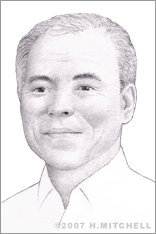Shuji Nakamura
Shuji Nakamura was born on May 22, 1954 in Ikata, Ehime, Japan. He completed a degree in electronic engineering at the University of Tokushima in 1977, followed by a master’s degree in 1979. More than a decade of research led to his 1993 development of the blue light-emitting diode, or LED, which has enabled the creation of the white-light-emitting LED, the first viable, ultra-efficient successor to the incandescent light bulb invented by Thomas Edison in 1878.
After completing his studies, Nakamura began working in the research and development division for Tokushima-based Nichia Chemical, a small maker of phosphor for CRT tubes and fluorescent lamps. There he studied purified gallium metal, a source material of gallium arsenide and gallium phosphide used to make red and infrared light-emitting diodes. He spent several years conducting research on gallium phosphide crystals, gallium arsenide crystals, and gallium aluminum wafers, which resulted in his development of three novel products for his employer. However, each time, he was a little too late. Larger competitors came out with similar products at the same time that he was perfecting them and made it impractical for relatively small Nichia to manufacture the goods. The situation was different with his fourth success story: high-brightness blue LEDs.
Nakamura proposed his project to his company’s chairman and was surprised when the executive approved funding for his research. Blue LEDs had long been considered the “holy grail” for those inside the industry. This is because as computer and electronics systems increasingly use light to transmit, store, and process data, the specifications of the lasers used within these devices have become more important. Many consumer devices, such as CD and DVD players, have typically used infrared and red laser sources to read and write data onto a disc via a focused beam of light. Green LEDs were available as well (the development of these was also among Nakamura’s achievements), but blue LEDs proved more difficult to achieve, despite the millions of dollars many large companies poured into research on the subject.
Blue light has a shorter wavelength and thus a smaller width for focused beams of light, within which data can be more densely packed. In fact, it makes capacity for storage in a given area four times what it was with infrared. When combined with red and green light, blue light makes it possible to produce white-light-emitting LEDs, which are essential for a variety of consumer and industrial applications.
The key to Nakamura’s creation was his development of a process for making what is known as a strongly “p-type” gallium nitride, or GaN, used to produce the blue laser diode. The process he created made mass production of blue LEDs possible. Blue light has already begun to revolutionize the electronics and lighting industries, with companies such as Sony, Samsung, Toshiba, and others using blue lasers in consumer products, including DVD players. In addition, white LEDs are a low-cost, super-efficient alternative to light bulbs that are quickly gaining popularity in the U.S. and Europe and could help bring electric lighting to developing countries.
Blue LEDs went into production in 1993. Nakamura was awarded his doctorate in engineering from the University of Tokushima in 1994. He left Nichia Corporation in 1999 and took a position as a professor of engineering at the University of California, Santa Barbara (UCSB) in its College of Engineering’s Department of Materials. There, he has established a well-respected research program in new areas of nitride research. Recent projects include a blue-violet LED and zero-energy-loss LEDs, which would be close to 100 percent efficient.
In 2001, Nakamura made international headlines when he sued Nichia over his bonus for his blue LED work, originally around $180. The parties settled in 2005 for $8 million.
Meanwhile, Nakamura has received numerous awards for his achievements, including the 2006 Millennium Prize, the Nikkei BP Engineering Award, the IEEE Lasers and Electro-Optics Society Engineering Achievement Award, the British Rank Prize, the Julius-Springer Prize for Applied Physics, and the Asahi Award. He received the Nobel Prize in Physics together with Prof. Isamu Akasaki and Hiroshi Amano in 2014. Nakamura holds over 200 US patents and over 300 Japanese patents.


